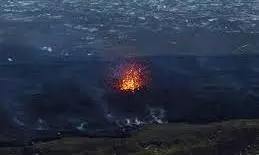
Volcano erupts in Iceland, coast guard dispatched for assessment
text_fieldsReykjavík: A volcano in southwest Iceland has erupted, marking the fifth eruption on the Reykjanes peninsula since 2021.
The Civil Protection Agency has deployed a Coast Guard helicopter to assess the situation and determine the exact location of the eruption, said Iceland's meteorological office.
The eruption was initiated north of the fishing town of Grindavik, but the specifics of where the lava is emerging and its directional flow remain unclear, according to broadcaster RUV.
This recent event follows the eruption in the Svartsengi volcanic system on December 18, which led to the complete evacuation of Grindavik's 4,000 inhabitants and the closure of the Blue Lagoon geothermal spa, a renowned tourist destination. Fortunately, Grindavik was spared as the lava took a different path away from the town, reported Reuters.
The eruption was of the fissure type, meaning that lava oozed from cracks in the ground rather than from a central vent. This is less explosive but still poses risks.
Iceland is known for its regular volcanic activity which occurs approximately every five years. But, there has been a noteworthy shift in frequency since 2021.
Instead of the usual cycle, eruptions are now taking place at a rate closer to every 12 months. This surge in activity is primarily associated with the Reykjanes Peninsula, which, after 800 years of dormancy, has unexpectedly reawakened.
The Reykjanes Peninsula has been dormant for nearly eight centuries but now it has disrupted the typical volcanic rhythm of the region.
Iceland, situated between the Eurasian and North American tectonic plates, two of the planet's largest, is a seismic and volcanic hotspot due to the divergent movements of these plates. The location known as the Mid-Atlantic Ridge is the spreading plate boundary where the North American and Eurasian plates are moving apart.
The ongoing eruptions on the Reykjanes peninsula underscore the dynamic geological activity in this region.
This movement creates cracks in the Earth's crust, allows molten rock to rise to the surface and contributes to Iceland's geothermal energy which is used to heat homes and generate electricity. On the other hand, they cause hazards like ash clouds and flooding.























